
Manila, officially the City of Manila, is the capital of the Philippines. It is one of the oldest cities in the world, as well as the most densely populated city proper in the world as of 2018. It was the first chartered city by virtue of the Philippine Commission Act 183 on July 31, 1901 and gained autonomy with the passage of Republic Act No. 409 or the "Revised Charter of the City of Manila" on June 18, 1949. Manila, alongside Mexico City and Madrid are considered the world's original set of Global Cities due to Manila's commercial networks being the first to traverse the Pacific Ocean, thus connecting Asia with the Spanish Americas, marking the first time in world history when an uninterrupted chain of trade routes circled the planet. Manila has been damaged by and rebuilt from wars more times than the famed city of Troy and it is also the second most natural disaster afflicted capital city in the world next to Tokyo yet it is simultaneously among the most populous and most wealthy cities in Southeast Asia.

The University of the Philippines Manila (UPM) is a state-funded medical and research university located in Ermita, Manila, Philippines. It is known for being country's center of excellence in the health sciences, including health professional education, training, and research. It is the oldest of the seven constituent universities of the University of the Philippines System, even predating the founding of UP by three years. Originally established on December 1, 1905 as the Philippine Medical School and later called as the UP College of Medicine and Surgery on June 10, 1907. It was renamed as University of the Philippines Manila in 1983.

The Rizal Memorial Sports Complex, (RMSC) is a national sports complex of the Philippines, located on Pablo Ocampo St., Malate, Manila. It is named after the country's national hero, José Rizal. The whole complex is currently managed by the Philippine Sports Commission, while the property is owned by the Manila City government.
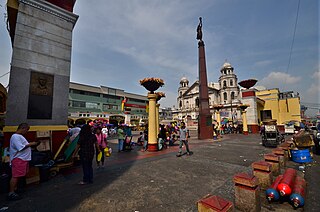
Plaza Miranda is a public square bounded by Quezon Boulevard, Hidalgo Street and Evangelista Street in Quiapo, Manila. It is the plaza which fronts the Minor Basilica of the Black Nazarene, one of the main churches of the City of Manila, and is considered as the center of Quiapo as a whole. Inaugurated in its current form by Mayor Arsenio Lacson in 1961, it is named after José Sandino y Miranda, who served as the Philippines' Secretary of the Treasury between 1833 and 1854.
This is a list of current and former national capital cities in the Philippines, which includes during the time of the Spanish colonization, the First Philippine Republic, the Commonwealth of the Philippines, the Second Republic of the Philippines, the Third Republic of the Philippines, the Fourth Republic of the Philippines and the current Fifth Republic of the Philippines.
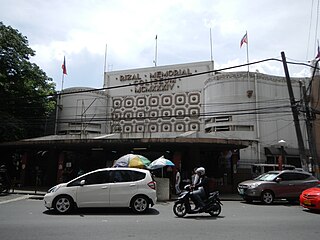
The Rizal Memorial Coliseum is one of two indoor sporting arenas located inside the Rizal Memorial Sports Complex in Manila, Philippines, the other being the Ninoy Aquino Stadium. The capacity of the coliseum is 8,000.

The architecture of the Philippines is a reflection of the country's historical and cultural heritage. Most prominent historic structures in the archipelago are based on a mix of indigenous Austronesian, Chinese, American, and Spanish influences.

Pablo Sebero Antonio, Sr. was a Filipino architect. A pioneer of modern Philippine architecture, he was recognized in some quarters as the foremost Filipino modernist architect of his time. The rank and title of National Artist of the Philippines was conferred on him by President Ferdinand Marcos in 1976.

The National Historical Commission of the Philippines is a government agency of the Philippines. Its mission is "the promotion of Philippine history and cultural heritage through research, dissemination, conservation, sites management and heraldry works." As such, it "aims to inculcate awareness and appreciation of the noble deeds and ideals of our heroes and other illustrious Filipinos, to instill pride in the Filipino people and to rekindle the Filipino spirit through the lessons of history."

Ancestral houses of the Philippines or Heritage Houses are homes owned and preserved by the same family for several generations as part of the Filipino family culture. It corresponds to long tradition by Filipino people of venerating Ancestors and Elders. Houses could be a simple house to a mansion. The most common ones are the "Bahay na Bato". Some houses of prominent families had become points of interest or museums in their community because of its cultural, architectural or historical significance. These houses that are deemed of significant importance to the Filipino culture are declared Heritage House by the National Historical Commission of the Philippines (NHCP), previously known as the National Historical Institute (NHI) of the Philippines. Preservation is of utmost importance as some ancestral houses have come into danger due to business people who buy old houses in the provinces, dismantle them then sell the parts as ancestral building materials for homeowners wishing to have the ancestral ambiance on their houses. These ancestral houses provide the current generation a look back of the country's colonial past through these old houses.

The National Cultural Heritage Act is a law, or Republic Act, of the Republic of the Philippines. It created the Philippine Registry of Cultural Property and took other steps to preserve historic buildings that are over 50 years old. It was signed into law on March 25, 2009.

The Luneta Hotel is a historic hotel in Manila, Philippines. Named after its location across from Luneta on Kalaw Avenue in Ermita, it is one of the remaining structures that survived the Liberation of Manila in 1945. The hotel was completed in 1919. According to the study by Dean Joseph Fernandez of the University of Santo Tomas, the hotel was designed by the Spanish architect-engineer Salvador Farre. The structure is the only remaining example of French Renaissance architecture with Filipino stylized beaux arts in the Philippines to date. After being closed down and abandoned in 1987, the hotel was relaunched in May 2014 with the installation of a historical marker by the National Historical Commission of the Philippines.
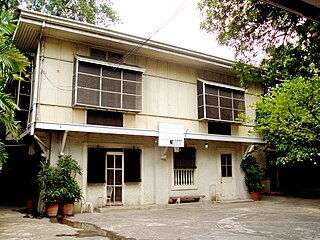
The Lichauco Heritage House, formally known as the O'Brien-Lichauco Heritage House is one of the oldest surviving houses in Santa Ana, Manila, Philippines. Originally built in 1859, the house was purchased in the late 1940s by a prominent Filipino lawyer and dignitary, Marcial Lichauco from a European family who had fled the Japanese occupation in the Philippines. The house was declared as a heritage house by the National Historical Commission on July 10, 2010. The Lichauco Heritage house is located along Pedro Gil Street. It is the only declared Heritage House in Santa Ana, and one of the only two declared heritage houses in Metro Manila along with Mira-Nila House in Quezon City.
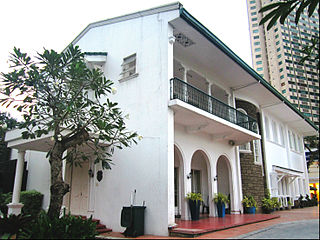
The Jose P. Laurel Residence or Villa Pacencia is a historic house located at 515 Shaw Boulevard in Mandaluyong, Metro Manila. The three-storey house was built in 1957 and was one of the three houses owned by the President of the Second Republic of the Philippines, José P. Laurel.

Lucky Chinatown is a shopping mall in Binondo, the Chinatown of Manila, Philippines. The 108,000-square-metre (1,160,000 sq ft) shopping mall is located on Reina Regente Street and De La Reina Street just south of Recto Avenue and Divisoria. It is owned and managed by Megaworld Corporation.

José María V. Zaragoza was a Filipino architect.

The Cultural Center of the Philippines Complex, also known as CCP Complex, is an 88-hectare (220-acre) owned by The Cultural Center of the Philippines (CCP) located along Roxas Boulevard in Metro Manila, Philippines, most of which fall under the jurisdiction of the city of Pasay.
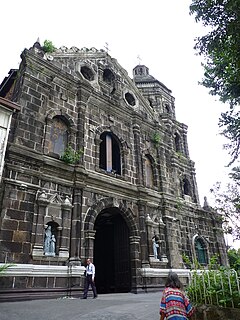
The Santa Ana Heritage Zone is a portion of the district of Santa Ana, Manila, Philippines, that was declared a heritage zone in 2014 by the National Historical Commission of the Philippines (NHCP). A larger portion of district was previously declared a histo-cultural heritage/overlay zone by the city government of Manila in 2011.




















